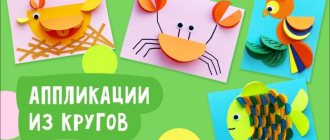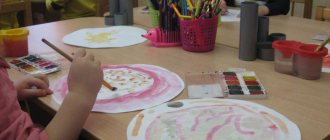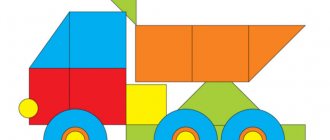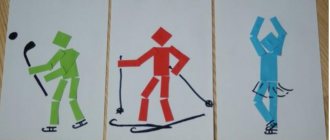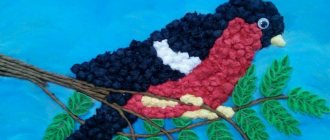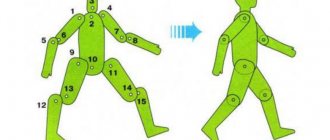Appliqué lesson in the senior group
The implementation of applications in the senior group is based mainly on a combination of different geometric shapes
This is interesting. Applique is a very ancient art form. Initially, our ancestors used it to appease the gods and performed it on animal skins as a basis. For the image itself, fur, leaves, etc. were used. In the Middle Ages, applique became the property of knights, who, by making amulets, protected themselves from the enemy. Today, appliqué is considered an integral attribute of children's creative development.
Applications are perceived by many adults as one of the ways to keep children busy and to please their relatives with touching crafts - they say, the day in kindergarten was not in vain. But in fact, the role of this type of composition is much more significant. After all, the application develops
- logical thinking (by reinforcing the concepts of geometric shapes, children try to transform them from one to another, for example, from a circle to a hexagon);
- creative abilities (as well as a sense of composition, because the children will have to correctly and beautifully distribute the details on the base sheet);
- ability to work in a team and benefit from the experience of other people;
- the ability to independently cut out parts;
- develops finger motor skills and visual acuity;
- promotes neatness.
Tasks
The teacher’s goal is to involve children in the preparatory stage as much as possible, as this develops in them
- responsibility for the quality of the result (if you haven’t prepared some detail in advance, then the craft may not work out at all);
- ability to plan your work;
- sense of time (when you need to calculate how much to spend on preparation so that there is time left for creativity).
Preparatory stage on the topic
Children should definitely be involved in the preparation of appliqué classes, so they will develop responsibility for the results of their work
The imagination of a kindergarten teacher can only be compared with the imagination of the child himself.
Materials
To make applications as part of the study of modes of transport, in particular trolleybuses, you can use
- paper;
- cardboard (including thick paper, which is used for packaging men's shirts);
- pieces of fabric;
- plasticine;
- natural materials (for example, leaves, pine cones, acorns), etc.
These materials can be used both for making the trolleybus itself and for the base for the picture. To decorate or decorate a trolleybus (for example, an advertising banner on the body), you can offer sequins, adhesive rhinestones, colored confetti, etc.
Of course, without the material and technical base there will be no work. So little creators need to be provided
- comfortable chairs standing near the tables;
- necessary supplies (scissors, glue, tablecloth for creativity).
What size parts are appropriate?
Despite the fact that children in the older group are almost adults, it is still difficult for them to work with crafts whose dimensions exceed the parameters of a standard A4 sheet. So in the case of a trolleybus, you should limit the size of the base and the figure itself. Since in the process of work it is necessary to repeat information about geometric shapes, the size of small parts should be such that children can not only turn, for example, a circle into a hexagon, but also be able to count the angles of the resulting figure without covering it entirely with their own fingers. So the optimal applique size is A4 for the base and ½ A 4 for the trolleybus itself.
What can children do?
The guys in the older group already have an idea of working with applications: they often do it in class. So it is quite reasonable that the preparation of parts and accessories falls on their shoulders. Thus, kids can be given a number of instructions.
- Prepare the necessary tools. Usually this is a special box in a closet in a group where scissors, glue, brushes, etc. are located, that is, the guys just have to take it out of the box and lay out everything that each “creator” needs.
- Organize your workspace. Cover the tables with oilcloth and position a chair so that it is comfortable to sit and work.
- Cut the blanks according to the pattern suggested by the teacher. If we are talking about paper applique, then these are circles-wheels, a rectangle-interior, squares-windows, as well as strips for rod-collectors (what we call “horns”).
Motivation
As a motivating task, you can illustrate the movements of finger gymnastics with a short poem about a trolleybus
In order for the preparatory stage not to absorb all the enthusiasm of little artists, the little ones need to be properly motivated before starting to perform the actual application. There are several options that can be used alone or in different combinations.
Survey
To begin with, you should ask the kids how they get to the kindergarten. After the answers “by car”, “by bus”, etc. follow, we can move on to the conclusion that all these types of modes of transportation are called “transport”. And the last “bridge” to the topic: a task to list the types of transport known to children.
Riddle poems
Children love to answer in chorus.
For example,
I'm running, holding on to the wires
I will never get lost!
- Oh, what a long mustache! You can get hooked! Why don't you, my friend, shave in the morning!? -What are these strange words? I don’t have a mustache, but two! “The most important thing for us is the mustache!” - Everyone will say troll-boo-sy!
Fairy tales
This is one of the most effective techniques not only to motivate children to complete a task, but also to develop the speech of little toddlers.
Ponomarenko Elena, https://www.neizvestniy-geniy.ru/cat/literature/skazki/284445.html
The Tale of the Sad Trolleybus
| In one city fleet there lived different cars: buses, trolleybuses, taxis. They all served the people faithfully and reliably. We got up very early, with the first rays of the awakening sun, and went to bed very late, when the night had cast a starry blanket over the city, when all the girls and boys had been asleep for a long time and were seeing wonderful dreams. New Year was approaching. The most fabulous and joyful holiday in the world. Decorated forest beauty trees sparkled in the houses. Balls and Christmas tree decorations sparkled, and the garlands on the city Christmas tree set up in the square sparkled and shimmered in the light. The city was waiting for the approach of the holiday, gifts for small and large - everyone, everyone, everyone from Father Frost and the Snow Maiden. More and more often, children clapped their hands in delight at the multi-colored rockets and loud firecrackers flying into the sky. But the old trolleybus had none of this and therefore it stood sad and was no longer happy about anything. The seats in his cabin were old, and almost all of them had been cut up by thin, sharp razors by bad boys. Someone was constantly littering the cabin: seeds and pieces of paper were lying here and there. People didn’t want the trolleybus to be clean, comfortable, and that made him even sadder, he even wanted to cry. By morning, the frost moved through the trees, grew frost on them, silvered the needles of the pine trees, painted the windows of the trolleybus with wonderful, magical patterns, made him smile a little, just a little, just a little. - Why are you so sad? – Morozko asked him. - Everyone has a holiday, New Year is coming, but I don’t have a holiday. “I’m old, almost useless to anyone,” the trolleybus answered him. “It’s not right to celebrate the New Year like that!” Open the doors, please, and turn on the headlights, I will sweep you up, clear you of papers and seeds. “Please,” the trolleybus answered indifferently and opened the doors for Frost. Frost whistled, the wind swirled the debris and brought the trolleybus interior to perfect cleanliness. Blizzard wiped off the backs and seats with a white towel, wiped the dim light bulbs and they glowed brightly and cheerfully. The old trolleybus smiled, hummed with joy, and the engine started working. - Thank you, Morozko. “No, miracles are just beginning,” Morozko answered him. – Now, when you leave the car park and your horns touch the wires, don’t be afraid, I have prepared a small gift for you, New Year is coming soon. Frost and I will try to keep you from being sad. You'll see what happens. Blinking its clean headlights, the trolleybus looked around the interior in which it would today transport passengers - children and adults. The salon was clean and beautiful, it was time to go. The trolleybus slammed the doors, smiled again and drove out of the bus depot. And then a miracle happened. Crackling, the horns slowly moved along the stretched wires and glowed with a beautiful blue-blue light. - What is this? Miracles! “No,” Frost whistled after him. - These are fireworks in your honor! Not from firecrackers, not from rockets, but real blue-blue fireworks. Today he will accompany you everywhere. Accept your New Year's gift. Don't be sad! The old trolleybus, smiling, looked at the miracle gift. That's how Frost and his brother frost created a miracle! They brought back the old man’s smile, gave him a fabulous gift and a good mood for the whole day. “How important it is to start the day with a smile and end it smiling too!” - thought the old trolleybus and went on its way. |
Tale about Trolleybus
| In one southern city there lived a Trolleybus who liked to imagine himself as various animals and birds. “I am a big and important elephant,” he said, walking heavily up the mountain. “Darling, let’s hurry up, people are late,” the driver Kostya, a young, cheerful guy, hurried him. - It’s better to imagine that you are an ostrich. – Is an ostrich bigger than an elephant? - asked Trolleybus. “An ostrich runs faster.” “Well, then I’m an ostrich,” he agreed and rushed so that the passengers fell on each other. “Be careful,” Kostya asked. – Try to turn into a kangaroo, and imagine that all the passengers are your children. – Where do kangaroos live, are there trolleybuses? - asked the Trolleybus - Yes, - answered Kostya, although he didn’t know for sure whether there were Trolleybuses in Australia - And they are beautiful, - asked the Trolleybus - You are still more beautiful, - answered Kostya And this was the true truth, because every morning Kostya watched to ensure that the sides of the Trolleybus were cleanly washed, and the windows sparkled with sunbeams. “I am a caring mother of Kangaroo,” the trolleybus told Kostya, slowed down and smoothly approached the stop. “The Yunost Cinema is the final stop,” announced the driver Kostya, and passengers poured out of the trolleybus like baby kangaroos from a bag. “It’s starting to rain,” the trolleybus said. “I’ll get wet.” – Imagine that you are a hippopotamus and swimming on a hot summer day, hippos love water very much. The trolleybus, snorting and shaking off the water, rushed through the streets. At night in a deserted and dark park, in order not to feel lonely, the trolleybus reassured himself: “I’m a bear, I sleep in my own den and I’m not at all bored or scared.” The time until morning did not last so long then. He also liked to imagine himself as a singing crane, and the bars, moving to another line, did not grind, but whistled gently like a bird. But one day, Kostya was summoned by telegram to his brother’s wedding. Kostya took a vacation and went north to Murmansk. Another driver was assigned to the trolleybus - the gloomy Uncle Petya, who was constantly concerned about the difficult economic situation in the country, but was especially angry after yesterday's quarrel with his wife over delayed salaries. - I am a gray wolf, I will eat you! - the trolleybus told Uncle Petya. “And you’re in the same place,” Uncle Petya got angry and hit the steering wheel with all his might. The trolleybus was offended and stopped. No matter how Uncle Petya hit the wheels or slammed the hinged lids, he did not move. In the trolleybus depot, the best repairmen worked their magic on the mechanisms for a long time, found nothing and left the trolleybus alone. The trolleybus hid in the farthest corner of the park and began to wait to be sent for scrap. But finally Kostya returned. “Your trolleybus is broken,” the dispatcher told him, “go get another car.” Kostya was upset and thought that maybe he could still do something for his friend. He searched for it for a long time until he discovered a dirty and abandoned trolleybus among broken down cars near the fence. Kostya washed the trolleybus inside and out, installed the bars and turned on the engine. “I’m an angry and scary gray wolf,” Trolleybus told Kostya not very confidently, “And I’ll eat you.” “Don’t eat me, gray wolf,” Kostya smiled as usual, “Let’s sing a song instead.” “I missed you so much,” Trolleybus complained. “Me too,” Kostya sighed and asked: “What are we going to sing?” - A song about me, that is, about a pink elephant. I am now a mighty but kind elephant. “Let’s talk about you,” Kostya agreed, and they sang in chorus: “Where the baobab trees came out on the slope. There lived a pink elephant in a clearing.” “Today I am the happiest Trolleybus,” thought the Trolleybus, leaving the park, and like a white ship sailed along the city streets. |
Pictures, posters depicting a trolleybus
Visualization is a mandatory element when working with applications. Moreover, these should be both drawn versions and photographs depicting real trolleybuses.
Observation
If possible, during a walk you can watch real trolleybuses, discuss their design, talk about current and wires. If this is not possible, then you can devote a few minutes of play time to looking at toy trolleybuses and comparing them with already known buses.
Lesson note plan
In the lesson notes on application, it is necessary to indicate the time allotted for each stage.
First, we formulate the goals and objectives of the lesson. For example, goals: to continue work on constructing geometric shapes according to a model, to teach how to cut circles by cutting off corners from square shapes, to develop an interest in artistic activities.
Tasks could be the following: teach children to make circles from squares, continue to develop the skill of working with scissors, and instill neatness and accuracy in work.
As for the formulation of a mandatory element of any lesson in the senior group related to speech development, on the application it can be vocabulary work (familiarity with the concepts of “gasoline”, “ground transport”, “schedule”, “stop”)
After the introductory part, we move directly to the course of the lesson, which includes three stages:
- introduction or motivation - rhymes, fairy tales (no more than 7 minutes);
- the main part is doing crafts together with the teacher (18 minutes);
- the final stage is summing up, the teacher praises the children, a spontaneous exhibition of works is formed on the magnetic board (5 minutes).
Example of a summary
If there is very little time for the application, then you can invite parents to complete the task at home: find suitable pictures and stick them on the base cardboard to make a trolleybus
Truck applique
Children love to watch massive and large vehicles that amaze them with their majesty. Therefore, if a child is impressed by what he sees on the street, this is an excellent reason to make an applique with him at home. Necessary materials:
- Drawing.
- Cardboard.
- Scissors.
- Pens or pencils.
- Glue.
First you need to download a dump truck template made from thick paper, which many have already assembled. This will make the preparation process easier and the child will not lose interest in work. It is recommended to print the template on white cardstock.
If you only have regular printer paper, this will work too. However, cardboard is better, it is thicker and stronger. This will make it easier to draw the pattern on colored thick paper, and it will retain its shape for a long period.
After the pattern is printed, you next need to cut out the parts using scissors. For realism, add a little brown color for the ground, this is optional.
Using a torn technique, it can be added to the very bottom; each detail is glued with a glue stick. All parts are first placed on the base and then glued using regular PVA. You can complement the concept using watercolors, drawing clouds, houses, the sun, etc.
Lesson notes on the application “Funny Trolleybus”
| Goal: Development of children's constructive abilities Objectives: – Improve knowledge of round, rectangular and square shapes. -Learn to transform shapes by cutting a rectangle into squares. – Teach children to use scissors carefully and work with glue. – To develop the ability to correlate one’s actions with the actions of an adult. – To consolidate the concept of “passenger transport”, “urban transport”, its types. Preliminary work: use of ICT, conversations about passenger transport, looking at pictures of a trolleybus , reading poetry, riddles. Vocabulary work: activation of adjectives: passenger, mobile, electric, urban. Progress of educational activities Educator: Guys, please look at these pictures. Tell me what is shown on them? Children: Bus, trolleybus , tram, minibus. Educator: Correct, but how can all this be called in one word? Children: Transport. Educator: What kind of transport is this? Children: Passenger, city. Educator: Why do we call it that? Children: Because it transports people - passengers. Educator: Okay, well done. Educator: Who saw the trolleybus ? (Children's answers). Guys, come to the computer and I will show you a trolleybus that travels along the city streets. Knock on the door Teacher: Guys, the postman just brought me a letter, now I’ll read it to you. (Reads the letter) “Hello guys! The Krasnodar traffic inspector is writing to you. I am making a request: unforeseen circumstances arose in Krasnodar, trolleybuses and there was only one left. And therefore, many adults and children cannot get to work, kindergarten, or school. I hope for your help. Goodbye, thank you for early.” Educator: Guys, are you ready to help? (Children's answers) Educator: Well done, I'm glad that you figured out how to help in this situation. Before we get to work, let's exercise our fingers. Finger gymnastics: Transport We will squeeze our fingers. We will call transport: Car, helicopter, tram, bus, plane. We clenched five fingers into a fist and named five types of transport. The teacher asks questions: What parts does the trolleybus ? Children: From the carriage, windows, doors, wheels. Educator: How does the trolleybus ? Children: Pantograph. Educator: Who knows how a trolleybus differs from a bus? Children: The bus is fueled with gasoline, and the trolleybus runs on electricity. Educator: Now guys, let's get to work. (The teacher explains and shows techniques for cutting corners and folding a rectangle in half several times) Physical exercise “Name the transport” After the children have completed the task, the teacher suggests looking at the resulting work together. Educator: Guys! Look how we worked together and what wonderful trolleybuses we made ! Did you like trolleybuses ? Which one did you like best? Why? Do you think we helped the residents of Krasnodar? (Children's answers) |
Volumetric machine applique
Many adults remember this option. Previously, there were children's magazines on sale, where the authors included special car templates for appliqué for children, from which they assembled a full-fledged car.
Today it is difficult to find something like this; adults can print any model on their own. Assembly instructions are simple:
- You can use the suggested options.
- Next, the vehicle is printed on a thick A4 sheet.
- After that, it is cut along the dotted line.
- For convenience, a ruler is used; it will help make the folds even.
- Next, the parts are glued together with tape or PVA glue.
Thus, you can make any model that will become a full-fledged interior decoration. The work is suitable for older people, as gluing and folding parts requires skill.
The procedure for making an application with a photo
The first example is a trolleybus with two windows.
After completing the application, it is worth making an exhibition of children's works so that the kids have an incentive for further work
Instructions:
- We show the children the toy.
- Let's start with the largest part - the interior. Take a large rectangle and round the top corners.
- From square blanks, rounding the corners, we make wheels.
- We attach them to the interior.
- We also apply the smallest window squares to a rectangle with a rounded top.
- We apply current collector strips to the top.
- Glue the parts to the base.
The next version is more complicated. It requires cutting and pasting not only windows, but also doors.
If in class the children have already made an appliqué bus, then making a trolleybus will not be difficult for them
Instructions:
- Take a large rectangle, do not round the corners.
- Glue it onto the base.
- Cut out 2 wheels (from squares).
- We glue rectangles of windows to the left and right of the interior body.
- Let's start gluing the doors.
- We take a rectangle, add a small rectangle to the narrow side - steps.
- In the middle we draw a line - a sliding door.
- Repeat steps 6–7 again for the second door.
- Glue the doors to the center of the wheels.
- There is another window between the doors.
Ambulance application
The sound of an ambulance can be heard several hundred meters away, such a car attracts attention. Making it at home using the appliqué technique is quite simple. What we need for the colored paper applique machine:
- Colored paper.
- White cardboard.
- Scissors.
- Glue.
Let's start with a minibus template. It consists of two parts - a body and a frame with wheels. First we make the body, having previously estimated the size on paper. We also make the rear part of the body separately and glue it to the roof using glue.
After this, you need to cut out a cross separately and place it on the body. Red flashing lights and black wheels are cut out separately, depending on the size of the overall part.
All parts are carefully glued to the cardboard. If you have an old stencil at home that you can use to make letters, you should definitely use it.
Website for children and parents - about school, preparation, education, study...
Serious little truck! It is, perhaps, more important than a passenger car (Even the largest one). The load is carried by a truck - He is not used to being lazy. Loaded, lucky, buzzing: “Get out of the way! Move away! A lot of cargo fit into my large spacious body. I'm in a hurry to deliver them on time! If only someone could help..." A.
Abstract of the educational activity on speech development “Transport” In the junior group “Osinka” Teacher Savonko N.L. Objectives: Replenish vocabulary about varieties.
Guys, do you think we can fly away in such a balloon? Why? What kind of transport can we use to fly? Then we use our work to decorate the locker room. I was pleased to vote for your wonderful applications. They develop imagination, fine motor skills, perseverance, etc. And how wonderfully children consolidate their knowledge of geometric shapes.
TWO BOGATYRS (MARCH 8) (Fon-ma - entrance “Tam-tibidam-pam-pam”) (Children enter the hall with flowers and build two semicircles) Ved: The sun always brings joy...
Excellent master class, wonderful work. The appliqués of a boat, a train, and a rocket are made neatly and colorfully. MK is accessible and detailed. I liked the poems. The assigned tasks were fully completed.
You can offer them step-by-step instructions with a detailed description of how to make all the details of the future picture, as well as a step-by-step diagram for sewing buttons in the appropriate places, as shown in the photo.
Educator: Well done guys (the teacher removes the scarf from the easel where there are illustrations of cars and other objects).
Fabric machine applique
This part of the master class is suitable for mothers who want to decorate towels or bed linen for their babies. Stripes are often used for identification in kindergartens; teachers may ask them to buy them or make them themselves.
The technique is quite simple, especially if you have a sewing machine at hand:
- First you need to choose bed linen or clothing on which embroidery will be done.
- Next, you need to download and print a special machine template for the applique. It will make the work much easier.
- After this, the threads are selected.
- The sewing machine is refueled and you can start working.
- Each detail is carefully stitched.
You can also do this work on a separate piece of fabric to use the machine as a patch. If the work is done for a kindergarten or camp, it is appropriate to add the name or the first letters of the initials. This can also be done using standard stitches.
If you don’t have a machine at hand, you can do the appliqué by hand, which will take more time.
Applique is a great way to develop motor skills and creative skills in a child. Working together brings adults and children closer together, which will have a positive impact on relationships in the future.


